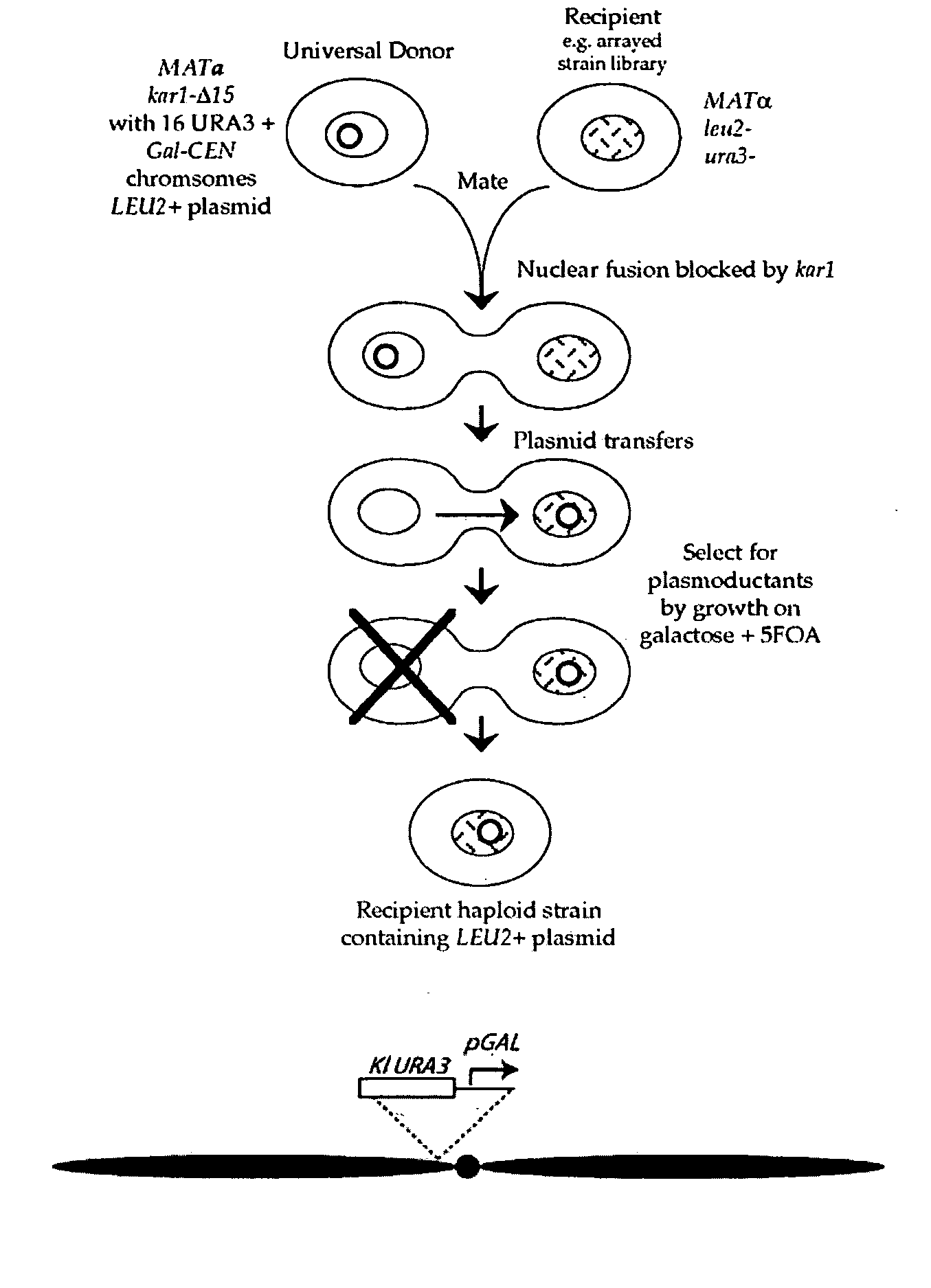Donor yeast strain for transfer of genetic material
a technology of genetic material and donor yeast, applied in the field of donor yeast strain for genetic material transfer, can solve problems such as drug sensitivity or metabolic deficiency, and achieve the effect of reducing the need
- Summary
- Abstract
- Description
- Claims
- Application Information
AI Technical Summary
Benefits of technology
Problems solved by technology
Method used
Image
Examples
example 1
Transfer of Plasmid Permitting the Regulated Expression of a DNA Topoisomerase I Protein Mutant
[0093] This example illustrates a screen of the gene disruption library with a catalytic mutant of DNA toposiomerase I. Mutation of Thr 722 to Ala shifts the catalytic equilibrium of Top1 toward the covalent enzyme-DNA intermediate mimicking the action of the chemotherapy drug camptothecin (Megonigal et al. 1997). Overexpression of TOP1-T722A results in cell death while low level expression is tolerated. However, in DNA repair deficient strains, even low levels TOP1-T722A expression results in cell death (Reid et al. 1999). Several classes of genes affect sensitivity to camptothecin and TOP1-T722A expression. These include DNA repair genes, lagging strand replication genes, and DNA damage checkpoint genes. Thus screening for genes affecting Top1-T722A expression in the deletion library can be used to compare the ability of this new screen to find genes already known to affect topoisomeras...
example 2
DNA Topoisomerase II
[0110] The TOP1-T722A mutant discussed above is a specific allele that introduces lesions in the cell by altering catalytic function of the enzyme. Another type of allele that can be screened by overexpression is a catalytically dead allele. We have generated the top3-Y355F catalytic mutant to examine its affect when overexpressed in yeast. The Y to F alteration was constructed by PCR using specific primers to introduce the mutant sequence, which was subsequently cloned under the control of the pGAL1 promoter for inducible high-level expression. The galactose-inducible mutant, the wild-type allele and a vector control were transformed into a diploid W303 strain and streaked onto plates containing galactose (FIG. 9). Overexpression of the top3-Y355F mutant confers severe slow growth in the diploid similar to a homozygous null top3 mutation. Just like a top3 mutant strain, the slow growth of the overexpressed Y to F mutant is suppressed by mutation of sgs1 as well...
example 3
DNA Topoisomerases II
[0111] To evaluate the automation of the method, the plasmoduction screen will be extended to include alleles of DNA topoisomerases II & II. For Top2, we will produce a top2-Y793F mutation (Worland and Wang 1989) for these screens. We will evaluate the effect of the top2-Y793F mutant expression in a wild-type strain background. Since TOP2 is essential, it is possible that overexpression of this allele will produce a null phenotype. In this case, we will titrate the expression level via copper concentration in the medium to produce a sub-lethal expression level. Strains expressing the top2-Y793F mutant will be evaluated for growth rate, sensitivity to topoisomerase II specific drugs, and rDNA recombination frequency in order to determine if sub-lethal expression has a cellular effect. Similar to TOP1 and TOP2 alleles, we will screen both wild-type and the catalytic top3-Y355F mutant. As demonstrated in the preliminary results, it appears that top3-Y355F expressi...
PUM
| Property | Measurement | Unit |
|---|---|---|
| Fraction | aaaaa | aaaaa |
| Fraction | aaaaa | aaaaa |
| Fraction | aaaaa | aaaaa |
Abstract
Description
Claims
Application Information
 Login to View More
Login to View More - R&D
- Intellectual Property
- Life Sciences
- Materials
- Tech Scout
- Unparalleled Data Quality
- Higher Quality Content
- 60% Fewer Hallucinations
Browse by: Latest US Patents, China's latest patents, Technical Efficacy Thesaurus, Application Domain, Technology Topic, Popular Technical Reports.
© 2025 PatSnap. All rights reserved.Legal|Privacy policy|Modern Slavery Act Transparency Statement|Sitemap|About US| Contact US: help@patsnap.com



